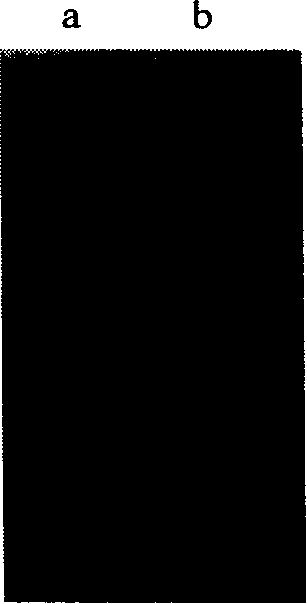Hybridoma cell line and anti-human erythrocyte surface H antigen monoclonal antibodies generated thereof
A hybridoma cell line, monoclonal antibody technology, applied in the direction of anti-receptor/cell surface antigen/cell surface determinant immunoglobulin, fusion cells, cells modified by introducing foreign genetic material, etc., can solve the problem of genetically engineered antibodies. Reduced affinity, affecting the binding activity of genetically engineered antibodies, and not being completely faithful
- Summary
- Abstract
- Description
- Claims
- Application Information
AI Technical Summary
Problems solved by technology
Method used
Image
Examples
Embodiment 1
[0064] Example 1. Obtaining of hybridoma cell line 2E8Z and identification of the monoclonal antibody 2E8 produced against human erythrocyte surface H antigen
[0065] The inventors of the present invention have prepared a hybridoma cell strain capable of producing anti-human erythrocyte H antigen, named 2E8Z, and the cell strain has been preserved in the General Microbiology Center of the China Microbiological Culture Collection Management Committee in Zhongguancun, Beijing on February 08, 2007 , the preservation number is CGMCC No.1942, and the specific construction method can be found in the literature (Li Hui, Pan Jichun, Liu Zi, Liu Jinghan, Zhang Jingang. Development and characteristic identification of non-aggregating monoclonal antibody against human erythrocyte membrane antigen[J]. Journal of Molecular Immunology 2005, 21(4):473-475). The monoclonal antibody produced by the cell line was named 2E8, the agglutination titer of the monoclonal antibody was 1:1024, and the...
Embodiment 2、2E8
[0066] Cloning of Example 2, 2E8 Monoclonal Antibody Variable Region Gene
[0067] Use the following method to clone the heavy chain variable region and light chain variable region encoding genes of the 2E8 monoclonal antibody. The specific process includes the following steps:
[0068] 1. Extraction of total RNA
[0069] The total RNA of the hybridoma cell line 2E8Z CGMCC No.1942 obtained in Example 1 that can produce anti-human erythrocyte surface H antigen was extracted with the TRIzol kit of Invitrogen and referring to the kit instructions.
[0070] 2. Synthesis of cDNA
[0071] Using the total RNA obtained in step 1 as a template, oligo(dT) 15 For primers, use Invitrogen’s SuperScript TM -II reverse transcriptase and perform reverse transcription according to the instructions, 50 μL reaction system and reaction conditions: total RNA 10 μL, ol igo(dT) 15 1 μL, 2.5mmol / L dNTPs 4μL, incubate at 65°C for 5min, then ice bath for 5min, microcentrifuge, then add 5× reverse t...
Embodiment 3
[0084] Embodiment 3, the cloning of fusion protein gene 2E8R3 and the construction of the Escherichia coli expression vector containing this fusion gene
[0085] 1. Cloning of fusion protein gene 2E8R3
[0086] Cloning by flexible peptide (Gly4Ser) using the following method 3 (SEQ ID NO: 5 in the sequence listing) The fusion protein (named 2E8R3) gene 2E8R3 of the monoclonal antibody 2E8 heavy chain variable region and light chain variable region obtained by connecting the anti-human erythrocyte surface H antigen obtained in Example 2 , the specific process includes the following steps:
[0087] 1. Design primers
[0088] Heavy chain variable region and light chain variable region encoding gene and flexible peptide (Gly4Ser) of the monoclonal antibody 2E8 cloned according to Example 2 3 Design primers for the coding sequence, the primer sequences are as follows:
[0089] 2E8H BACKNEW (upstream primer): 5'- ggatcc caggtgcagttgaaggagtcagga-3' (SEQID NO: 14, the underline...
PUM
 Login to View More
Login to View More Abstract
Description
Claims
Application Information
 Login to View More
Login to View More - R&D
- Intellectual Property
- Life Sciences
- Materials
- Tech Scout
- Unparalleled Data Quality
- Higher Quality Content
- 60% Fewer Hallucinations
Browse by: Latest US Patents, China's latest patents, Technical Efficacy Thesaurus, Application Domain, Technology Topic, Popular Technical Reports.
© 2025 PatSnap. All rights reserved.Legal|Privacy policy|Modern Slavery Act Transparency Statement|Sitemap|About US| Contact US: help@patsnap.com



